 |
|

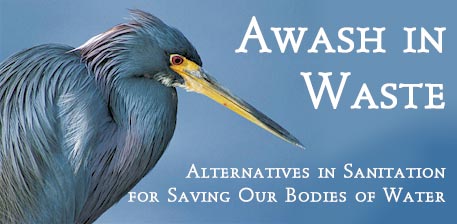
by Annie Birdsong
Modern man is ingenious, but history may still call us fools.
We have harnessed the power of the atom and discovered ways
to communicate instantly and travel almost effortlessly across
the ether to the farthest reaches of the globe, yet we still
wash human and animal waste into our bodies of water.
Consider the impact
these wastes are having on a body of water that was once among
the world's richest estuaries—the Chesapeake Bay in
the mid-Atlantic region of the United States.
Its skies were often darkened by blizzards
of snow geese and immense flocks of great blue herons, swans,
diving ducks, terns, pintails, mallards, Canada geese, osprey,
bald eagles and more.
The naturalist John James Audubon wrote
in 1840 that when the air in the Chesapeake "turned crisp
and the leaves fell from the trees, the skies filled with
a million to a million and a half ducks." He described
a profusion of underwater grasses that provided food for the
waterfowl throughout the winter.
It was the Indians who first called this
estuary Chesapeake, which means great shellfish bay—a
name given for its abundance of blue crabs, soft shell clams
and immense beds of oysters that filtered the entirety of
the bay’s water every three or four days.
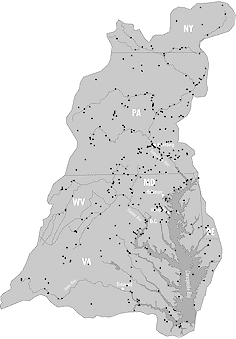
The Chesapeake Bay
watershed with water treatment facilities noted as black
dots.
Click image for larger graphic.
Graphic courtesy Chesapeake Bay Foundation. |
The Great Decline
The Indians lived off the bounty of the Bay
20,000 years without degrading the water quality; but modern
man brought the ecosystem to the edge of collapse in the blink
of an eye—a few short decades—with modern sewage
systems, agribusinesses, chemicals, large-scale, high-polluting
technologies and free trade practices.
Today, oyster beds are one percent of their
historic high and more than 40 percent of the waters are dead
zones—too starved of oxygen to sustain aquatic life.
Crabs scramble to the beaches just to breathe, the bloated
bodies of dead fish wash up on the shores, and watermen pull
up crab pots full of dead crabs.
And today, the seagrasses have drastically declined,
just as they have across the world—a sign our water
bodies are dying. Of the 600,000 acres of seagrass that once
provided oxygen to the water and formed the base of a rich
ecosystem, only 69,126 acres remain in the Chesapeake.
Crabs have lost a source of food: the tiny zooplankton
that lived on the leaves of the seagrasses; without this food,
they sometimes "starve or eat each other," and the
"underfed female crabs don't have enough energy to reproduce,"
says Dr. Ronald Eisler, a senior research biologist at the
U.S. Geological Survey's Patuxent
Wildlife Research Center. Young fish, young crabs and
molting crabs have lost shelter and refuge from their predators.
The underwater grasses used to be the main
food for waterfowl, said Dr. Matthew Perry, a habitat management
specialist also with the Patuxent Wildlife Research Center,
adding that without this food source, "many ducks don't
make it though the winter."
Some species of waterfowl in the Bay have declined significantly—especially
redhead ducks, which have declined by 96 percent, and black
ducks, which have declined by 67 percent.
As the grasses disappear, the water turns muddy.
There is nothing to slow the wind-caused currents or keep
the sediments from resuspending.
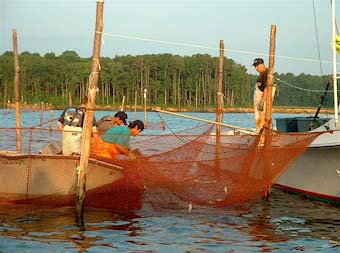
In the summer of 2003,
fishermen reported a record
number of dead fish and crabs—excess nitrogen is to
blame.
Photo courtesy Chesapeake Bay Foundation.
Awash in Waste
Scientists say one of the most significant
causes of the decline of seagrasses and oxygen is both treated
and untreated human excreta and animal waste. Wastewater flows
into the bay from the toilets, showers, sinks and washing
machines of 16 million people—around 1.5 billion gallons
every day from almost 500 sewage treatment plants situated
on the 48 major rivers and hundreds of smaller creeks, streams
and rivers that empty into the Chesapeake from parts of New
York, Maryland, New Jersey, Pennsylvania, Delaware, Virginia,
and West Virginia.
The bay also receives immense quantities of
manure from large-scale animal farms in the watershed. In
the Delmarva Peninsula alone, there are more than 2,700 chicken
farms with 623 million birds and at least 800,000 tons of
waste per year.
When all areas in the watershed are included,
88 billion pounds of manure from chickens, hogs, cattle and
turkeys are generated every year. Manure is often stored as
a liquid in lagoons the size of several football fields. These
can leak and overflow into rivers, creeks and streams, along
with runoff from fields where immense quantities of manure
is sprayed simply to dispose of it.
The nutrient-enriched water causes an explosive
growth of tiny plants and animals that coat the leaves of
the seagrasses. This film prevents photosynthesis by keeping
the sunlight from penetrating the leaves and the vegetation
dies.
Also, as the sewage and manure rot, the bacteria
use up the oxygen in the water. The nutrients from waste,
the farm fertilizers, and the nitrogen in air pollution also
cause anoxia—oxygen depletion—by stimulating an
overgrowth of algae; when the algae die and fall to the bottom,
the bacteria that thrives on the dead algae depletes the oxygen.
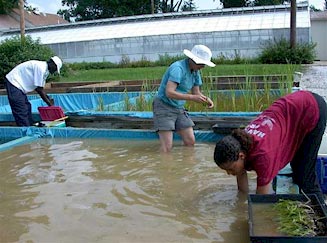
In July 2003, the Chesapeake
Bay Foundation led a largescale
volunteer underwater grass planting across the Chesapeake.
Photo courtesy Chesapeake Bay Foundation.
Female Urine and
Feminized Fish
Another staggering problem with water treatment
plants is that the urine they dump into waterways contains
synthetic estrogens from birth control, which is feminizing
male fish—a problem reported in the United Kingdom,
but not restricted to that area. Researchers with the U.S.
Geological Survey reported that waterways in the United States
have levels of these substances equivalent to those levels
found to be harming fish in the U.K.
Researchers with the agency detected 15 sex
and steroidal hormones in U.S. streams, as well as 22 veterinary
and human antibiotics, 19 human drugs such as antidepressants,
and 39 industrial and household wastewater products, including
plasticizers, detergents, insecticides, solvents, and disinfectants.
Dr. Susan Jobling with Brunel University in
the U.K. said across England, high proportions—up to
100 percent—of male fish have been feminized to some
extent, with eggs in their testes and/or female reproductive
ducts.
Scientists with the U.K.'s Environment Agency
said in some rivers, half the fish can no longer produce sperm
and thus have a diminished capacity to reproduce.
The Breaking Point
Aquatic biota are among the most endangered
of species. In the United States, 51 percent of crayfish,
69 percent of freshwater mussels, 18 percent of dragonflies
and damselflies, and 43 percent of stoneflies are at risk—either
endangered, threatened, presumed extinct, possibly extinct,
critically imperiled, imperiled or vulnerable—according
to the Natural
Heritage Network, which collects information from thousands
of biologists and has survey centers in all 50 U.S. states,
11 provinces and territories of Canada and in many countries
and territories of Latin America and the Caribbean. The centers
are often affiliated with universities or government research
institutes, and the data compiled by the network is widely
viewed as the most complete and detailed source of information
on biodiversity in the United States.
The problem of nutrient enrichment is compounded
by other sources of contaminants, such as hazardous effluent
from industry, toxic runoff from roads, and herbicides. Underwater
grasses began to die when the use of herbicides doubled and
then tripled in the watershed, which receives runoff from
60,000 farms and countless lawns. Herbicides also volatilize
into the air and are carried to the bay as gases or particulates
in the fog, wind, clouds, dust, snow and rain.
Researchers from the U.S. Department of
Agriculture's Beltsville
Agricultural Research Center in Maryland detected 18 kinds
of pesticides in the waters of the Chesapeake in the late
1990s. They also found that herbicides such as atrazine, simazine,
cyanazine and metholachlor were present throughout the year,
with individual concentrations higher in the late spring and
summer and declining in the fall.
Sewage systems and animal farms are a threat
even to the oceans. As water from bays mixes with ocean water,
human and animal waste makes its way to the ocean floor. In
other places there are microorganisms that can break it down,
but in some places, there are few or no microorganisms because
of oxygen depletion. Marine microbiologists are asking at
what point we will have dead oceans. Will it be 50 years?
Will it be 20 years?
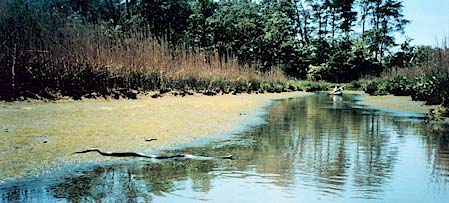
A large black rat snake
crosses a tidal inlet
in the marsh grass along Chesapeake Bay.
Photo by Mary Hollinger, courtesy NOAA.
Sweden Leads the
Way to Sustainability
The Swedish International Development Agency
has been working to promote a
variety of less "environmentally abusive" alternatives
to sanitation by pulling together a network of experts, organizations
and agencies across the North and South through an organization
called EcoSanRes,
which is managed by the Swedish Environment Institute.
"Water should not be a sink for waste,"
says EcoSanRes, adding that "even advanced sewage treatment
plants" are degrading ecosystems and the quality of surface
and groundwater with pathogens and nutrients.
The Cycles of Nature
The organization seeks to "link people
and soil" by teaching them to see that once properly
composted, human waste is a valuable recyclable material that
can be used in agriculture to improve human nutrition—a
concept the organization calls "closing the loop on nutrients."
To be sustainable, the same amount of nutrients taken from
a field should be returned to it in the form of compost, says
EcoSanRes.
Composting human feces and urine for use in
agriculture began in China during the 12th Century or before.
The idea spread to Japan, probably when Zen Buddhists traveled
to China to study.
Japanese farmers were greatly impressed with
the gains in productivity when they used humanure
as a fertilizer. They began paying people for their excreta,
keeping the urban areas clean and disease free.
The Chinese composted this waste along with
animal waste, grass clippings, soil brought into the village
and huge amounts of mud from the canals, which was rich in
organic matter from the snails and other aquatic biota that
lived in the water. Using this organic matter, they were able
to maintain the fertility of the soil for 3,000 years in spite
of the intense usage of the land due to severe population
pressures.
In contrast, the United States has "exhausted
strong virgin fields" in three generations, wrote F.H.
King, a professor of agricultural physics and chief of the
division of soil management with the U.S. Department of Agriculture,
who visited these countries in the mid 1920s and wrote a classic
book called Farmers of Forty Centuries:
Or Permanent Agriculture in China, Korea and Japan.
EcoSanRes says feces and urine that are composted
become humus/compost that "smells like good earth"
and has many benefits for the soil because it:
- Teems with microorganisms that break down
organic matter and return nutrients to the soil all through
the growing season, including trace nutrients such as boron,
manganese, iron, copper and zinc.
- Increases the water-holding capacity of the
soil to help plants withstand drought.
- Helps neutralize toxins and heavy metals
in the soil so that plants do not absorb them.
- Helps plants withstand attacks by disease
and insects by enhancing naturally occurring microbial agents.
- Reduces the amount of plant parasites and
nematodes in the soil.
- Reduces the effects of soil/borne pathogens.
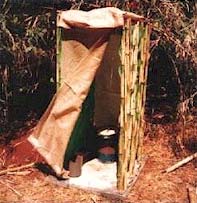
The ArborLoo portable
latrine in Zimbabwe, surrounded by a superstructure made
of reeds and fertilizer bags.
Photo by Peter Morgan. |
Ecological Toilets
The organization shares information on a variety
of ways ecological toilets might be made. The most common
is a urine diverting toilet, also called a dehydrating toilet,
that collects urine in a separate chamber—perhaps a
tank under the house.
The organization says after being stored about
six months, the urine might be collected by farmers, diluted
with water and used as a plant fertilizer on agricultural
crops, since urine contains 60 percent of the excreted nitrogen,
phosphorous and potassium.
The feces in the dehydrating toilet is sanitized
in the chamber by drying it and by adding lime, soil, wood
ash or other material after each use. The use of lime may
enhance pathogen destruction by raising the PH.
Usually, there are two chambers for the feces,
one for storage and one for active use. The material is not
sanitary enough to use as a fertilizer until it has been stored
for several months.
There are also composting toilets. In these,
soil or wood ash are used to prevent fly breeding, reduce
odor and promote composting. Screened ventilation pipes may
be used to aerate the chamber with oxygen and control moisture.
Layers of leaves or other organic matter are sometimes added
to speed decomposition.
The more versatile ArborLoo composting toilet
is similar to the other composting toilets except that it
is portable and uses a pit dug in the earth to hold the waste.
When the pit is three-fourths full, it is sealed with dirt,
a tree is planted in it and the toilet is moved to another
site in the yard.
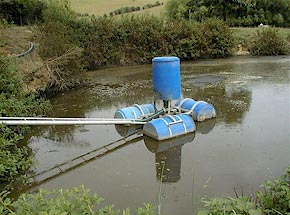
A floating pump in New Zealand dairyland sends a slurry of
water and manure to small irrigators that pull themselves
across a field using water power.
Photo by Bryan Petrucci, courtesy Grassfarmer.com.
The Traditional
Japanese Method of Sanitation
Many Japanese are turning to the environmentally
degrading Western flush toilets that use pipes to centrally
collect sewage. But in the 20th Century, the dominant Japanese
tradition of handling human excreta was to collect the dry
deposits in tanks below homes. A truck comes and vacuums out
the tanks every month. The material is taken to one of the
country's 1,800 night soil treatment plants where it is treated
using one of the most advanced technologies in the world,
including membrane separation for completely removing bacteria
and viruses and controlling odor, as well as a process for
denitrification.
An area that collects excreta in this manner
might opt to treat it in an anaerobic digester, without oxygen,
then in an aerobic digester, with oxygen, to reduce the bulk
of the material by 80 or 90 percent and transform it into
an excellent compost for farm fields.
In contrast, solids skimmed off during the sewage treatment
process for flush toilets is not fit for use on farm fields
because of high to very high contamination by heavy metals,
such as mercury, lead, cadmium and zinc, says EcoSanRes. These
substances enter sewage flows as businesses dump industrial
wastes down the drain and the waste treatment process concentrates
them in the sludge. According to the U.S. Environmental Protection
Agency, these heavy metals can not be broken down or degraded.
EcoSanRes says soil can not sustainably produce healthy, high
quality food if it accumulates heavy metals, yet in many areas,
including many areas in the United States, treated sewage
sludge is being applied to farm fields.
Renewable Energy
from Waste
The anaerobic digestion process produces a
valuable renewable source of energy—methane, also called
biogas, that can be used for heating water and buildings;
cooking; generating electricity; drying crops; operating water
pumps; running gas refrigerators; and powering vehicles. There
are about 100 biogas plants in Sweden, most of them in sewage
treatment plants or at landfill sites. In Malmo, Sweden, 200
city buses, 50 percent of taxis and municipal vehicles run
on methane.
In Vietnam, many families have simple digesters
that generate compost and biogas for cooking purposes from
human excreta and pig waste. They mix the waste in a concrete
container which has an opening at the bottom that allows liquid
to flow into a long, submarine-shaped plastic bag, where it
ferments. The methane gas flows out of the bag through a rubber
pipe attached to the top of the bag into another submarine-shaped
plastic bag that is affixed or floats on the ceiling of the
kitchen. The methane flows out of the bag though a rubber
pipe to a burner on the stove, where it is burned to cook
food. A belt around the plastic bag in the kitchen can be
tightened to increase the flow of methane to the burner.
Millions of digesters are in use in China, India,
Vietnam ,Cuba and other countries. They are often underground
and are used not only to produce compost for farm fields and
biogas for cooking, but also to boil water to make steam that
turns a turbine and generates electricity. These digesters
help prevent deforestation, since biogas rather than wood
is used for cooking.
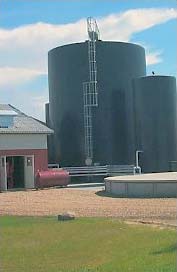
Anaerobic digesters
convert agricultural and animal wastes into fuel—and
are projected to be a $14 billion industry in the United
States once fully adopted.
Photo courtesy Microgy Cogeneration Systems. |
Cow Power and Cleaner
Waterways
Some farmers are making big money off manure.
Minnesota farmer Dennis Haubenschild puts the 20,000 gallons
of manure generated daily by his 850 cows in an anaerobic
digester that heats it to 90 or 95 degrees for about 20 days
to speed the rotting process, eliminate odors and capture
the methane.
When the process is complete, an engine burns
the methane to generate electricity. Haubenschild sells two-thirds
of the electricity—enough to power 78 homes—to
an electric cooperative, which pays him the retail rate of
7.3 cents per kilowatt hour. Federal legislation passed in
the U.S. in 1978 requires utilities to buy power at a reasonable
rate from independent producers. Haubenschild makes over $4,300
per month.
He uses one-third of the electricity to power
his electric milking parlor. And the waste heat given off
when the methane is burned to generate electricity is collected
to heat water that is circulated to warm the barn and heat
the digester.
The digestion process leaves behind a high
quality composted manure that has the consistency of crumbly
cake, as well as a liquid slurry that he sprays on crops.
This slurry—also called a liquor—is high in nutrients
that are more readily available to crops than fresh manure.
Also, if the rain washes the liquor or compost off the fields
into the waterways, it won't deplete oxygen the way fresh
unfermented manure does.
Haubenschild's digester cost $345,000, which
he paid for with grants from Minnesota state agencies. Digesters
will be used more widely when people realize that such technology
need not be expensive or complex, can be made locally and
can be used not only by farms, but also by homes and communities.
If we fail to implement such alternatives for
dealing with animal and human waste, aquatic biota could very
well go extinct, exposing huge gaps in the web of life: There
would be no salmon for the bears, no trout for the eagles,
no crayfish for the raccoons, no mayflies for the ducks and
little or no food for uncountable numbers of species.
Fossil records show that a large loss of tiny
aquatic plants the size of a grain of sand, called plankton,
once caused a mass extinction where about two-thirds of life
on earth died. It took the earth 10 million years to recover.
It’s better to leave future generations
a rich inheritance of clean water bodies teeming with a wide
variety of life.
 Annie
Birdsong recently
graduated from the University of Maryland with degrees in
political science and journalism and a minor in environmental
studies. She is now getting started in free-lance writing. Annie
Birdsong recently
graduated from the University of Maryland with degrees in
political science and journalism and a minor in environmental
studies. She is now getting started in free-lance writing.

Next
> >
|
|
 |
 |



Beltsville
Agricultural Research Center
Chesapeake
Bay Foundation
Chesapeake
Bay Program: Watershed Restoration Partnership
EcoSanRes:
Closing the Loop on Sanitation
National
Oceanic and Atmospheric Administration Coastal Services Center
NatureServe:
A Network Connecting Science with Conservation
Patuxent
Wildlife Research Center
U.S.
Environmental Protection Agency Office
of Water

1. Produced by Nicholls, Steve and Crawford,
Peter, The Great Encounter, [documentary
video], Alexandria, Va.: PBS Video, 1999.
2. Anderson, James L. Ph.D., "Non-Native
Oysters in the Chesapeake Bay," available on the National
Academies of Sciences website.
3. "Summer 2003 Oxygen Levels in Chesapeake
Bay," on the website
of the Environmental Protection Agencies Chesapeake Bay Program.
See also, no byline given, "Suffocating the Bay," Aug.
10, 2003, Washington Post, p.B06.
4. Polderman, P.J.G. and Hartog, C. Den, De
zeegrassen in de Waddenzee, Hoogwoud: Koninklijke Nederlandse
Natuurhistorische Vereniging, 1975.
5. "Growing Respect for Grass: SAV Beds
May Be Subject to Additional Protection," Bay
Journal, Vol. 7, no. 10, Jan./Feb. 1998.
6. Perry, Matthew; Osenton, Peter C.; Lohnes,
Edward J.R., "Diving Duck Distribution, Abundance and Food
Habits in the Chesapeake Bay," website
of the U.S. Geological Survey's Patuxent Wildlife Research Center.
7. Phillips, Ronald C. and Menex, Ernani G.,
Seagrasses, Washington, D.C.: Smithsonian
Institution Press, 1988.
8. Produced/directed/edited by Fincham, Michael
W. and Nelson, Mac, Chesapeake: The Twilight
Estuary, [documentary video] College Park, Md.: the University
of Maryland Sea Grant College, 1985.
9. Chesapeake Bay Foundation staff, "The
Monumental Challenge for Agriculture," July 17, 2003, on the
Chesapeake
Bay Foundation website.
10. "Deposition of Air Pollutants to the
Great Waters: Third Report to Congress," June 2000, available
on the EPA
website.
11. Lehotay, Steven J.; Harmon-Fetcho , Jennifer
A.; and McConnell, Laura L., "Agricultural Pesticide Residues
in Oysters and Water from Two Chesapeake Bay Tributaries,"
Marine Pollution Bulletin, Vol. 37,
no. 1-2, pp. 32-44, 1998.
12. Ibid, Fincham, Michael W. and Nelson, Mac.
See also, "Bay Trends and Indicators: Municipal Wastewater
Flow and Population," available on the website
of the Chesapeake Bay program.
13. Warrick, Joby and Shields, Todd, "Md.
Counties Awash in Pollution-Causing Nutrients; Reports Suggest State
Faces Battle Controlling Agricultural Runoff Into the Bay,"
Washington Post, Oct. 3, 1997, p.A01.
14. Williams, John Page, "Time is Running
Out to Reduce Agricultural Runoff to the Bay," Chesapeake
Notebook, on the website of the Chesapeake Bay Foundation,
August 4, 2003, on
the World Wide Web.
15. Ibid, Michael W. Fincham and Mac Nelson
16. "Department of Biological Sciences:
Intersex Fish Research at Brunel," available on the Brunel
University website.
17. Revkin, Andrew C., "Stream Tests Show
Traces Of Array of Contaminants," New
York Times, March 13, 2002.
18. Kolpin, Dana W. et al, “Pharmaceuticals,
Hormones, and Other Organic Wastewater Contaminants in U.S. Streams,
1999-2000: A National Reconnaissance,” Environmental
Science and Technology, Vol. 36, no. 6, pp. 1202-1211, 2002.
19. Ibid, Brunel University website.
20. Henderson, Mark, "Pill Effect Neuters
Half of Male Fish, The Times (London),
March 27, 2002, available on the Lexus Nexus database.
21. Stein, Bruce A. et al, Precious
Heritage: The Status of Biodiversity in the United States,
New York: Oxford University Press, 2000, pgs. 101-105.
22. Stevens, William K., "U.S. Found to
Be a Leader In Its Diversity of Wildlife," New
York Times, March 16, 2000.
23. Solutions for a Water
Short World, Chapter 4: “Consequences of Overuse and
Pollution,” a report available on the website
of the Population Information Program, Center for Communications
Programs, John Hopkins School of Public Health.
24. Esrey, Steven A.; Andersson, Ingvar; Hillers,
Astrid; and Sawyer, Ron, Publications on Water
Resources No. 18, "Closing the Loop: Ecological Sanitation
for Food Security," on the EcoSanRes
website.
25. Producer: Weiner, Marilyn; director/writer:
Weiner, Hal, Urban Explosion, [documentary
video], Washington, D.C.: ScreenScope, 1999.
26. Invisible Seas,
[documentary video], College Park, Maryland: University of Maryland,
Office of University Relations and University of Maryland, Dept.
of Microbiology, 1977.
27. "EcoSanRes: Closing the Loop on Sanitation:
Background and Vision," on the EcoSanRes
organization's website.
28. "State of the Art," on the EcoSanRes
website.
29. Matsuit, Saburo PHD, "Night Soil Collection
and Treatment in Japan," on the EcoSanRes
organization's website under "Ecological Alternatives: Casestudies."
30. Ibid, Esrey, Steven A. et al.
31. Ibid, Esrey, Steven A. et al.
32. Ibid, Esrey, Steven A. et al.
33. Ibid, Esrey, Steven A. et al.
34. Ibid, Matsuit, Saburo PHD.
35. Ibid, Matsuit, Saburo PHD . See also, Chapter
2: “Important Aspects of Ecological Sanitation,” on
the EcoSanRes
organization's website under "Ecological Alternatives.”
36. “Introduction to the National Pretreatment
Program,” on the Environmental
Protection Agency’s website.
37. Chapter 2: “Important Aspects of Ecological
Sanitation,” on the EcoSanRes
organization's website under "Ecological Alternatives.”
See also the following two articles: Fact
Sheet 4, "Municipal Solid Waste Composting: Potential
Effects of Heavy Metals in Municipal Solid Waste Composts on Plants
and the Environment," on the Cornell
Composting website, and "Toxic Waste in Fertilizer,"
on the Oregon
Toxics Alliance website.
38. “Bio Motor Fuels,”available on
the Swedish Energy
Agency website.
39. Fred Parker, "Incentives for Natural
Gas," Energy and Environment Management,
S9, Nov. 2002, available on the Business Management Practices database.
40. Writers: Reece, P.J. and Hamm, Jim; producer,
director: Hamm, Jim, Turning Down the Heat:
The New Energy Revolution, [documentary video] Olney, PA:
Bullfrog Films, 2000.
41. "Renewable Sources of Energy with Special
Emphasis on Biomass: Progress and Policies. Report of the Secretary-General,"
a report
by the Committee on New and Renewable Sources of Energy and on Energy
for Development, United Nations Economic and Social Council, on
the World Wide Web.
42. King, Tim, "At a Minnesota Dairy, Holsteins
Are in the Energy Business," Christian
Science Monitor, Nov. 21, 2002. See also, Powell, Joy, "Holsteins
Provide Raw Material to Run Dairy's Power Plant; Process Reduces
Odors and Produces Income for Princeton-Area Farm," Star
Tribune, March 12, 2001.
|









